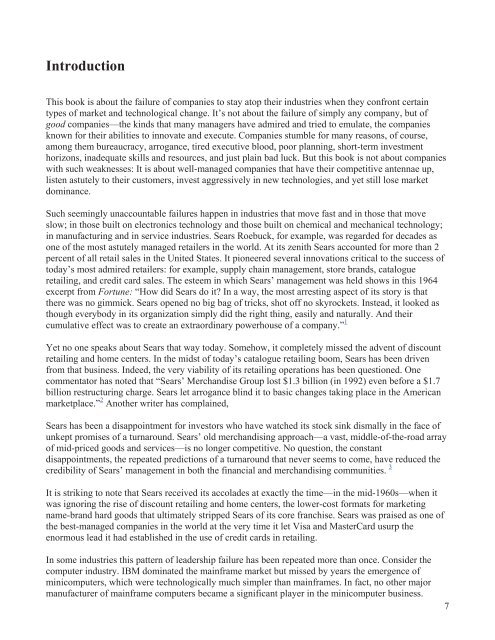PRUEBAS
PRUEBAS
PRUEBAS
Create successful ePaper yourself
Turn your PDF publications into a flip-book with our unique Google optimized e-Paper software.
IntroductionThis book is about the failure of companies to stay atop their industries when they confront certaintypes of market and technological change. It’s not about the failure of simply any company, but ofgood companies—the kinds that many managers have admired and tried to emulate, the companiesknown for their abilities to innovate and execute. Companies stumble for many reasons, of course,among them bureaucracy, arrogance, tired executive blood, poor planning, short-term investmenthorizons, inadequate skills and resources, and just plain bad luck. But this book is not about companieswith such weaknesses: It is about well-managed companies that have their competitive antennae up,listen astutely to their customers, invest aggressively in new technologies, and yet still lose marketdominance.Such seemingly unaccountable failures happen in industries that move fast and in those that moveslow; in those built on electronics technology and those built on chemical and mechanical technology;in manufacturing and in service industries. Sears Roebuck, for example, was regarded for decades asone of the most astutely managed retailers in the world. At its zenith Sears accounted for more than 2percent of all retail sales in the United States. It pioneered several innovations critical to the success oftoday’s most admired retailers: for example, supply chain management, store brands, catalogueretailing, and credit card sales. The esteem in which Sears’ management was held shows in this 1964excerpt from Fortune: “How did Sears do it? In a way, the most arresting aspect of its story is thatthere was no gimmick. Sears opened no big bag of tricks, shot off no skyrockets. Instead, it looked asthough everybody in its organization simply did the right thing, easily and naturally. And theircumulative effect was to create an extraordinary powerhouse of a company.” 1Yet no one speaks about Sears that way today. Somehow, it completely missed the advent of discountretailing and home centers. In the midst of today’s catalogue retailing boom, Sears has been drivenfrom that business. Indeed, the very viability of its retailing operations has been questioned. Onecommentator has noted that “Sears’ Merchandise Group lost $1.3 billion (in 1992) even before a $1.7billion restructuring charge. Sears let arrogance blind it to basic changes taking place in the Americanmarketplace.” 2 Another writer has complained,Sears has been a disappointment for investors who have watched its stock sink dismally in the face ofunkept promises of a turnaround. Sears’ old merchandising approach—a vast, middle-of-the-road arrayof mid-priced goods and services—is no longer competitive. No question, the constantdisappointments, the repeated predictions of a turnaround that never seems to come, have reduced thecredibility of Sears’ management in both the financial and merchandising communities. 3It is striking to note that Sears received its accolades at exactly the time—in the mid-1960s—when itwas ignoring the rise of discount retailing and home centers, the lower-cost formats for marketingname-brand hard goods that ultimately stripped Sears of its core franchise. Sears was praised as one ofthe best-managed companies in the world at the very time it let Visa and MasterCard usurp theenormous lead it had established in the use of credit cards in retailing.In some industries this pattern of leadership failure has been repeated more than once. Consider thecomputer industry. IBM dominated the mainframe market but missed by years the emergence ofminicomputers, which were technologically much simpler than mainframes. In fact, no other majormanufacturer of mainframe computers became a significant player in the minicomputer business.7


